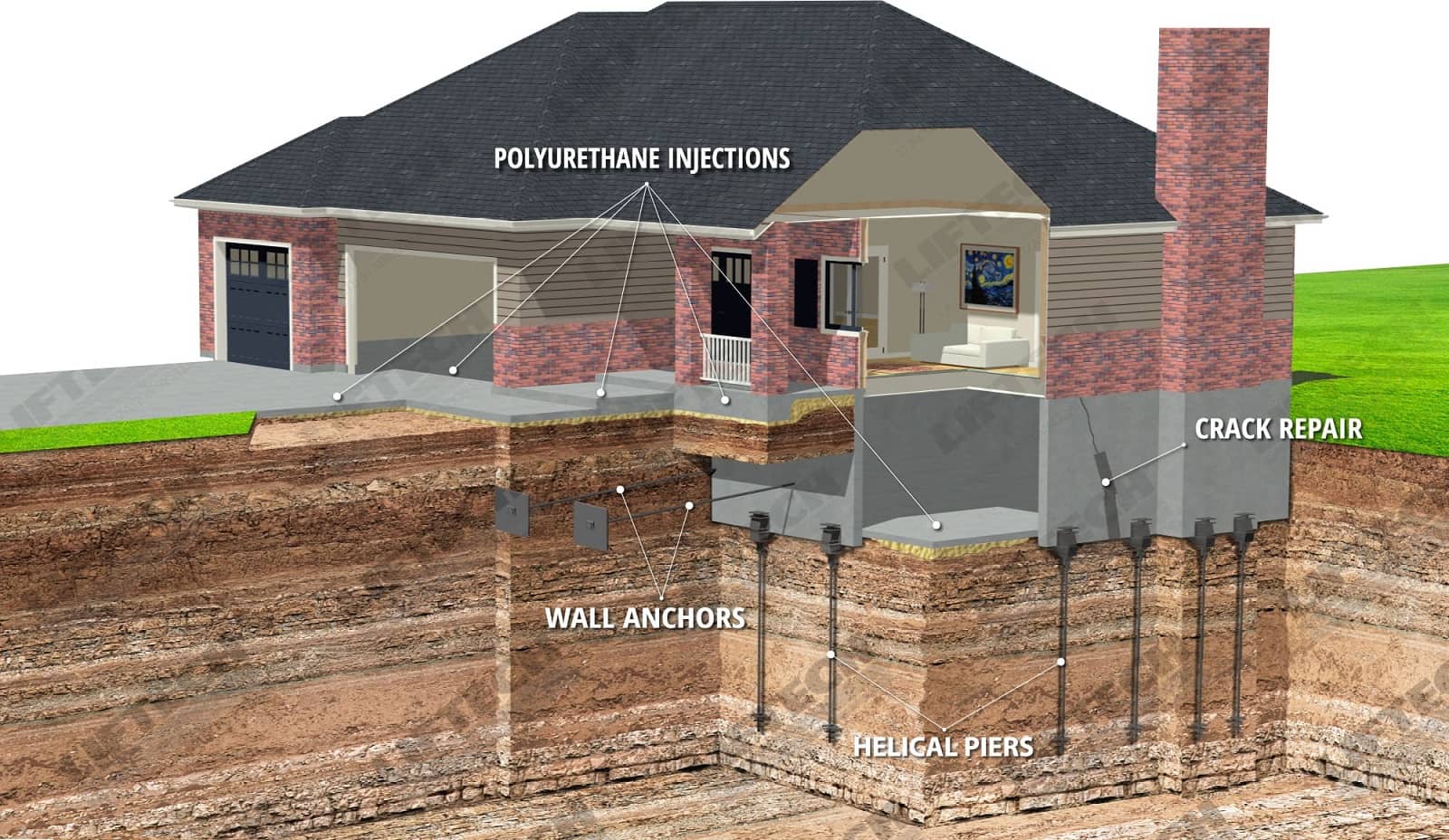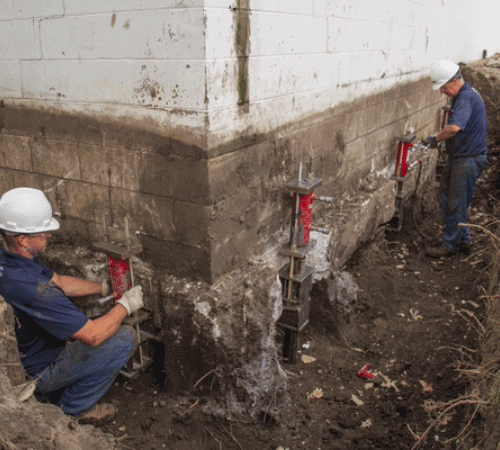Checking Out Various Methods of Structure Repair Work for Numerous Soil Kinds
Structure repair is an essential aspect of maintaining structural stability, specifically when considering the varied obstacles posed by different dirt types. The complexity of soil actions under differing conditions requires a customized strategy to repair, guaranteeing optimum services such as helical piers for unpredictable soils or chemical grouts for cohesive layers.
Understanding Dirt Types
Soil kinds play a vital duty in the stability and durability of structure structures, making it vital for home owners and building and construction specialists to recognize their qualities and behavior. The communication in between soil and foundation can determine the architectural stability of a structure. There are a number of soil types, each with distinctive physical residential properties that impact just how structures are developed and maintained.
Granular soils, such as sand and crushed rock, supply great drain and are typically considered secure. They have high load-bearing capabilities, which can support larger frameworks. These dirts can shift if not compacted effectively, leading to prospective settlement problems. In contrast, natural dirts like silts and clays show different actions. These soils often tend to keep moisture, and their load-bearing ability can vary considerably with adjustments in moisture web content.
Rocky dirts, recognized for their strength and security, offer excellent assistance for structures yet might call for specialized tools for excavation. Alternatively, loamy dirts, which are a balanced blend of silt, clay, and sand, usually give positive problems for structure support because of their modest drain residential or commercial properties.

Understanding these dirt types is critical for picking appropriate structure fixing approaches, making sure the longevity and safety and security of structures in time.
Challenges With Expansive Clay
Amongst the different soil types, extensive clay presents unique challenges for structure stability due to its tendency to go through considerable volume adjustments with wetness variation. This kind of soil swells when wet and contracts when completely dry, which can apply significant pressure on frameworks. These variations can cause foundation fracturing, heaving, and negotiation issues, posturing substantial threats to the architectural integrity of structures.
The challenges with large clay are worsened by its plasticity index, which gauges the dirt's ability to alter shape and quantity. A high plasticity index suggests better capacity for activity, boosting the likelihood of damage to structures. This is particularly bothersome in areas experiencing extreme or regular weather changes, where cycles of wet and completely dry problems are typical.
Additionally, the deepness of extensive clay layers can differ, making complex the assessment and planning of suitable structure fixing approaches. These intricacies need a comprehensive geotechnical examination to make sure efficient structure repair methods are implemented, highlighting the value of resolving large clay difficulties with know-how and treatment.
Solutions for Sandy Soils
Sandy soils, characterized by their big bit size and reduced cohesion, existing distinctive difficulties for structure security due to their propensity for moving and erosion. By anchoring the structure to deeper, extra steady dirt layers, these systems can supply the essential support to combat the shifting nature of sandy dirts.
Another suggested strategy is the application of soil stabilization methods. Chemical grouting, as an example, involves injecting a supporting agent right into the soil, which boosts cohesion and minimizes permeability. This process aids to solidify the sandy substrate, thereby lessening the danger of disintegration and movement.
Furthermore, installing appropriate water drainage systems is important in sandy dirt conditions. Guaranteeing ample drain can stop water accumulation around the foundation, which commonly exacerbates erosion and soil variation. Strategies such as French drains pipes or surface area grading can be employed to guide water far from the structure border.
Dealing With Clearing Up in Loamy Soils
Loamy dirts, recognized for their balanced mix of silt, clay, and sand, offer a fertile base for numerous frameworks however can often bring about structure settling as a result of their special structure. This well balanced structure supplies exceptional water drainage and nutrient retention, making it perfect for agriculture and landscaping. This same attribute can end up being troublesome for structures, as shifts in moisture material can cause the dirt to increase or agreement, leading to working out.
Addressing clearing up in loamy dirts calls for a complex approach. Precise soil testing is crucial to establish the certain structure and wetness material of the loam. Once data is gathered, implementing appropriate water drainage solutions is vital to maintain constant moisture levels, thus minimizing the risk of soil contraction or expansion. French drains or surface area grading are reliable techniques to reroute water far from the structure.

Innovative Fixing Methods
In the realm of foundation repair, cutting-edge methods are consistently being established to address the facility challenges positioned by numerous dirt problems. As dirt types differ considerably in their structural properties, standard methods might not constantly are sufficient. The advent of brand-new technologies in structure repair work provides a lot more customized services, making sure security and durability.
One notable technology is making use of helical piers, which are specifically effective in extensive or unpredictable soils (foundation repair okc ok). These piers are screwed into the ground up until they Visit This Link reach a steady layer of dirt, providing solid support for the structure above. This technique reduces interruption and is adaptable to various dirt kinds, making it a functional service
Another cutting-edge method is the application of polyurethane foam injection. This technique includes infusing high-density polyurethane foam below the structure to fill up gaps and stabilize the framework. It is a less invasive choice to standard base, using fast setup with very little disruption to the surrounding location.
In addition, soil stablizing approaches, such as the usage of chemical cements, have actually obtained traction. These compounds enhance soil stamina and lower permeability, protecting against future shifting. Collectively, these ingenious repair you can try these out service strategies give effective solutions for the varied obstacles posed by varying soil problems.
Final Thought

Foundation repair service is a vital facet of maintaining structural stability, specifically when considering the diverse difficulties positioned by various dirt kinds (foundation repair okc ok). The intricacy of dirt actions under varying conditions requires a customized strategy to fix, guaranteeing ideal options such as helical piers for unpredictable dirts or chemical grouts for cohesive layers. By securing the structure to much deeper, a lot more secure dirt layers, these systems can provide the required support to combat the moving nature of sandy dirts
Structure repair calls for mindful consideration of soil types to guarantee stability and longevity. Chemical grouts boost dirt stamina and minimize permeability in cohesive soils.